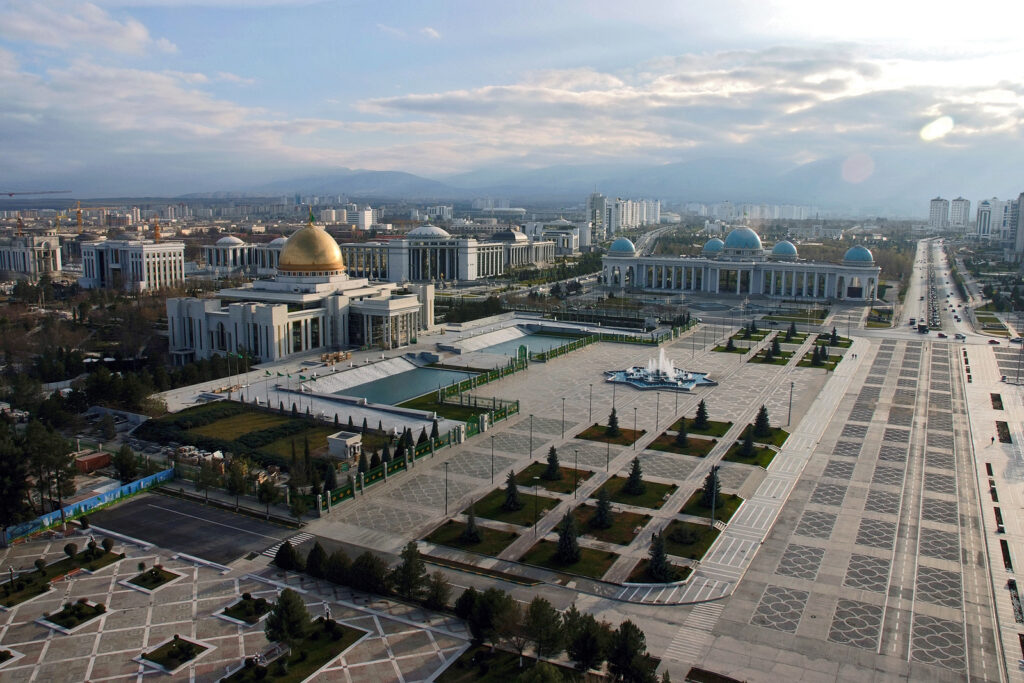When the eccentric Gurbanguly Berdymukhammedov stepped down as Turkmen president in 2022 after 16 years in office (having only recently amended the constitution in order to allow him to stay in the job indefinitely), he did so citing the need for “a younger generation” to run the country.
While it was clear that Berdymukhammedov had his son in mind for the presidency, hope nevertheless briefly blossomed in Turkmenistan that change might follow the transfer of power.
Two years after Serdar Berdymukhammedov replaced his father as president however, hope that the younger man would reform one of the world’s most closed societies have all but evaporated.
Indeed, what news of Turkmenistan that does filter out of the highly controlled country suggests that daily life for most of its people has become more austere as economic woes—despite headline high growth figures, ‘smart’ cities built of marble and caused in part by a failure to diversify away from petrochemicals and adopt market reforms—force the authorities in Ashgabat to take ever more drastic measures to ensure that a lid is kept on potential dissent.
Generous subsidies which for decades had provided Turkmen with almost free electricity, gas and water ended in 2019.
“Serdar Berdymukhammedov is expected to persist with the economic policies established by his predecessors, perpetuating a neopatrimonial system where the president’s family and close associates wield control over key economic assets, notably the country’s primary resource, natural gas,” says Sebastian Peyrouse, director of the Central Asia Programme and research professor at the Institute for European, Russian and Eurasian Studies at George Washington University.
“Despite periodic announcements of reform programmes, the regime’s reluctance to diversify and privatise the economy is rooted in preserving its predatory structure, contributing to a sustained negative impact on the population’s standard of living, social welfare, health, and food security.”
“The dynastic succession that saw Serdar Berdymukhammedov assume power maintains the nation’s authoritarian rule, characterised by repressive governance, the absence of freedom of expression and of a free civil society,” he adds.
Indeed, there is no opposition. The younger Berdymukhammedov was confirmed as the country’s new leader in March 2022 following a presidential election in which he took a generous 72.97 per cent of the vote (albeit well below the 97 per cent his father used to command), easily defeating eight other candidates on the ballot, all of whom were known for being loyal to the president and were not considered real competitors.
Two of the candidates were from the same party as the president. Turkmenistan has no prime minister, the president serving as both head of state and head of government.
According to Human Rights Watch, Turkmenistan’s government remains repressive, quashing religious and political expression that is not sanctioned by the authorities. The government tightly controls the media and access to information, prosecutes people who enable access to an uncensored internet, and allows no independent monitoring groups. The authorities also jail perceived opponents and government critics and harass activists abroad and their relatives in Turkmenistan. Dozens of people remain victims of enforced disappearance.
The government denies its citizens access to passport renewal services abroad, in contravention of international law, in an effort to force them to return to the country. Despite the ongoing economic crisis, Turkmenistan did not take any meaningful steps to address poverty in the country or to ensure food security for economically vulnerable groups.
Although Turkmenistan has institutions that could, in theory, provide checks and balances to presidential power, in reality they merely pay lip service to such duties.
For Peyrouse, a nuanced change is, nevertheless, conceivable on the international stage.
“Serdar’s exposure to foreign environments may prompt a shift from Turkmenistan’s isolationist stance, potentially easing its heavy reliance on China. This could open avenues for improved relations and offer the West a measure of leverage to advocate for reforms, albeit within limits.”
“A crucial concern for Turkmenistan in the next decade will be the restoration of its human capital, significantly eroded by an education system tailored to serve the authoritarian regime and foster a personality cult around the president,” he adds.
“Rehabilitating this human capital is poised to be a formidable challenge, demanding concerted efforts and time, with far-reaching implications for the country’s trajectory in the 2030s.”
An economy entirely reliant on gas exports
The state of the Turkmen economy is difficult to gauge given the almost total lack of reliable statistics. In September last year, the International Monetary Fund (IMF) openly questioned the reliability of official Turkmen data.
On paper at least, growth is strong. The government reported growth at 6.2 per cent in the first half of 2023, slightly above the six per cent reported a year earlier. According to the Asian Development Bank (ADB), expansion in the large hydrocarbon economy came mainly from reportedly higher production and exports of natural gas (the country has the world’s fourth largest deposits of natural gas), with almost all government revenue comes from the sale of natural gas, mostly to China, with a lesser dependence on the export of petrochemicals, cotton, and textiles.
Growth is set to continue to be high, at six per cent, in 2024, although the outlook remains dependent on revenue from hydrocarbon exports. Outside of the petrochemical industry, there is little foreign investment in the country and the government appears unable (or unwilling) to attract foreign investors nor diversify the economy away from oil and gas. “Too many of the right people do too well out of the current system for it to change,” says one Turkmen living in exile, in Brussels.
On the 2023 Index of Economic Freedom, published by the Heritage Foundation, Turkmenistan’s score of 46.5 placed it 161st of the 177 countries ranked. Turkmenistan is ranked 37th out of 39 countries in the Asia–Pacific region (only Burma and North Korea score less), and its overall score is significantly lower than the world and regional averages.
“Much-needed economic growth is severely constrained by long-standing institutional weaknesses that undermine the foundations of economic freedom,” Heritage Foundation wrote in its latest summary of the country. “The inefficient legal framework remains highly vulnerable to political interference, and heavy state involvement in the leading economic sectors dampens private-sector dynamism.”
The overall freedom to establish and run a business is very limited. The system is nontransparent, and enforcement is inconsistent. Regulatory codes are outmoded. The public sector provides most jobs, and the informal sector remains an important source of employment.
According to the Cotton Campaign, every year during the cotton harvest, which takes place between August and December (Turkmenistan is the world’s 10th largest producer of cotton), the Turkmen government forces tens of thousands of public sector workers, including employees of schools and hospitals, to pick cotton or pay for replacement pickers under threat of penalty, such as loss of employment.
The government also extorts money from the same workers to pay expenses related to the harvest. Furthermore, the government imposes cotton production quotas on farmers and enforces them with the threat of penalty, including fines and loss of land.
Smart city, smart football team
Berdymukhammedov senior meanwhile has maintained a high profile since stepping down as president. Officially the head of the People’s Council, the country’s highest constitutional body, Berdymukhammedov continues to act like a sitting president, receiving heads of state, attending government meetings, and indulging his pet projects, notably the newly built ‘smart’ city of Arkadag.
Inaugurated in June 2023, life for Arkadag’s residents is regulated by “digital and green technologies”, according to the Turkmen authorities. Carefully orchestrated news footage of the inauguration showed homeowners adjusting thermostats and operating vacuum cleaners with tablets. Built at a reported cost of around five billion US dollars for some 70,000 residents, it is impossible to estimate how many people actually live in the new city, nor if its ‘smart’ credentials are anything other than a gimmick (unlikely, given Turkmenistan’s lack of internet access).
What Arkadag does have is a football team, backed by Berdymukhammedov senior. It has, unsurprisingly, been highly successful. In 2023, its first season in the Turkmen top division, the team won all of its 24 matches scoring 83 goals and conceding just 17.







